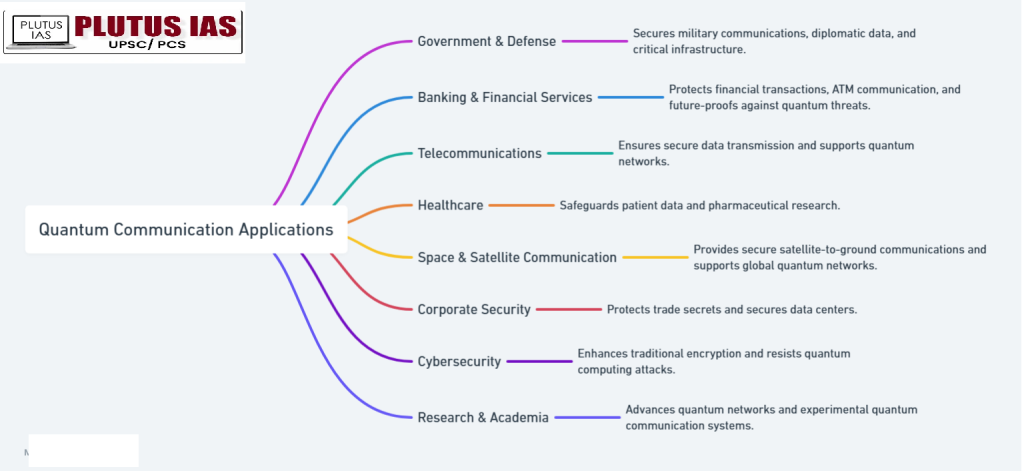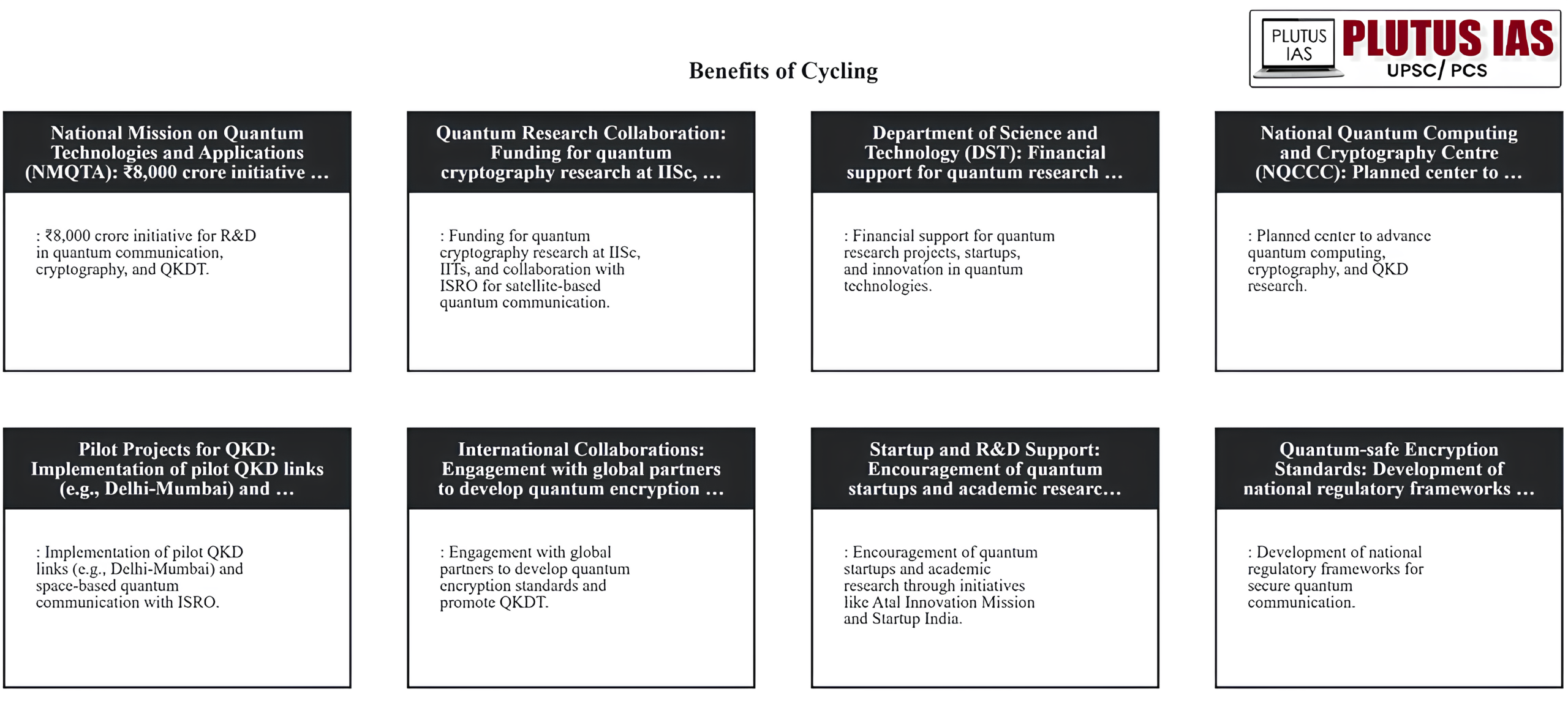13 May Quantum Key Distribution: A Breakthrough in India’s Cybersecurity Infrastructure
This article covers “Daily Current Affairs” and the Topic Quantum Key Distribution: A Breakthrough in India’s Cybersecurity Infrastructure
SYLLABUS MAPPING:
GS- 3- Science and technology –Quantum Key Distribution: A Breakthrough in India’s Cybersecurity Infrastructure
FOR PRELIMS
What is Quantum Key Distribution Technology (QKDT)?
FOR MAINS
What are the key features and advantages of Quantum Key Distribution Technology (QKDT) in ensuring secure communication?
Why in the News?
In a significant development towards enhancing India’s capabilities in quantum-secure communication, the Centre for Development of Telematics (C-DOT) has signed a Memorandum of Understanding (MoU) with Synergy Quantum India Private Limited, a deep-tech company specializing in quantum technologies. This collaboration aims to develop Drone-based Quantum Key Distribution (QKD) systems using the decoy-based BB84 protocol with polarization encoding, at Technology Readiness Level 6 or above. The initiative supports the goals of the Atmanirbhar Bharat mission by fostering indigenous R&D in emerging technologies. The partnership will also facilitate co-development of research proposals, academic dissemination, and organization of expert talks and symposia to promote innovation in quantum communication.
What is Quantum key distribution technology(QKDT)?
Quantum Key Distribution Technology (QKDT) is a cutting-edge method of secure communication that uses the principles of quantum mechanics to exchange encryption keys between two parties. The primary goal of QKDT is to ensure that encryption keys can be shared in a way that is provably secure—meaning that any attempt by an unauthorized party to intercept or tamper with the key can be detected immediately.
Key Features of QKDT:
1. Based on Quantum Physics: Unlike traditional encryption, which relies on complex mathematical algorithms, QKDT uses the fundamental laws of quantum mechanics—such as superposition, entanglement, and the no-cloning theorem.
2. Security Guarantee: If an eavesdropper tries to intercept the quantum key, the quantum state of the particles will be disturbed, alerting the communicating parties to the intrusion.
3. Use of Photons: The technology typically uses individual photons (light particles) transmitted over optical fiber cables to encode key information (called qubits).
4. Unbreakable Encryption: Because of quantum laws, QKDT cannot be cracked even by quantum computers, making it a key tool in future-proof cybersecurity.
5. Example Protocols: Popular QKDT protocols include BB84, E91, and Decoy State Protocols
QKDT vs traditional KDT
| Feature | Quantum Key Distribution Technology (QKDT) | Traditional Key Distribution (KDT) |
|---|---|---|
| Underlying Principle | Based on quantum mechanics (e.g., superposition, entanglement) | Based on mathematical algorithms and computational hardness |
| Security Basis | Physics-based – any eavesdropping disturbs the quantum system | Algorithm-based – depends on difficulty of solving problems |
| Eavesdropping Detection | Yes – intrusion alters quantum states and is detectable | No direct detection – intrusion can go unnoticed |
| Vulnerability to Quantum Computers | Not vulnerable – inherently resistant to quantum attacks | Vulnerable – quantum computers can break current algorithms |
| Key Transmission Medium | Photons over optical fibers or free-space channels | Classical communication channels like the internet |
| Example Protocols | BB84, E91, Decoy State Protocols | RSA, Diffie-Hellman, ECC (Elliptic Curve Cryptography) |
| Implementation Complexity | High – requires specialized hardware like single-photon detectors | Moderate – compatible with existing digital infrastructure |
| Key Distribution Range | Limited – typically up to 100–300 km over fiber (without repeaters) | Practically unlimited – via internet and global networks |
| Maturity and Adoption | Emerging – research and pilot projects ongoing | Mature – widely adopted in global systems |
| Use Cases | Ultra-secure communication (e.g., defense, banking, government) | General encryption across internet services and data exchange |
QKDT Applications

What are Govt.initiatives to promote QKDT in india

Challenges in QKDT application
1. Infrastructure Limitations: Quantum key distribution requires advanced infrastructure, such as high-quality fiber optic cables and photon detectors, which can be expensive and complex to implement.
2. Distance Limitations: The range of QKD is typically limited to around 100-200 km due to photon loss in transmission. Longer distances require specialized techniques, such as satellite-based communication.
3. Photon Loss and Noise: Transmission of photons through fibers or air is prone to loss, noise, and environmental interference, which can degrade the quality and security of the key exchange.
4. Scalability Issues: Scaling QKD systems for widespread use, particularly for large networks, is a significant challenge, especially due to the technical complexity and high cost.
5. Integration with Existing Infrastructure: Integrating QKDT with existing cryptographic systems and networks poses compatibility and security challenges.
6. High Cost: The cost of QKD equipment, such as photon detectors and quantum communication devices, remains high, limiting the widespread adoption.
7. Security Vulnerabilities: While QKDT offers theoretical security, real-world implementations may still be vulnerable to attacks like photon number splitting or imperfections in quantum hardware.
8. Regulatory and Standardization Issues: The lack of universal standards and regulatory frameworks for QKD can hinder its integration into commercial systems and widespread adoption.
Way forward
1. Enhanced Research and Development: Continued investment in R&D is crucial to overcoming the technical barriers, such as photon loss, noise, and scalability.
2. Infrastructure Development: Governments and private sectors should focus on developing and upgrading the necessary infrastructure for QKDT, including the installation of high-quality optical fibers, photon detectors, and quantum-safe hardware.
3. Cost Reduction: As the technology matures, economies of scale should help reduce the cost of key components such as photon detectors and quantum communication devices.
4. Standardization: International standardization bodies must work on defining and establishing universal standards for QKDT to ensure compatibility, scalability, and security across global platforms.
5. Integration with Existing Cryptographic Systems: Researchers and industry players need to develop hybrid systems that combine classical and quantum key distribution to ensure smooth integration with existing infrastructure and protocols.
6. Policy and Regulatory Framework: Governments should create clear regulatory guidelines and policies around the usage of QKDT to encourage innovation while safeguarding national security and privacy concerns.
7. Public-Private Partnerships: Collaboration between government agencies, research institutions, and private companies can expedite the development and deployment of QKDT, especially in areas like defense, banking, and communication sectors.
8. Awareness and Training: Building a skilled workforce through specialized training programs in quantum technologies will be essential for the smooth adoption of QKDT in various industries.
Conclusion
Quantum Key Distribution Technology (QKDT) offers a revolutionary approach to secure communication by leveraging quantum mechanics, ensuring encryption keys cannot be intercepted without detection. Unlike traditional cryptography, QKDT’s security relies on quantum principles, making it resistant to quantum computer threats. However, challenges like high infrastructure costs, limited range, and scalability issues remain. The Indian government is fostering QKDT development through initiatives like the C-DOT and Synergy Quantum India partnership, aiming to promote indigenous research. For broader adoption, continued advancements in R&D, infrastructure, standardization, and clear regulatory policies are necessary. As these hurdles are overcome, QKDT could significantly enhance cybersecurity across critical sectors such as defense and banking.
Download Plutus IAS Current Affairs (Eng) 13th May 2025
Prelims Questions
Q. Which of the following are key features of QKDT?
1. It uses classical algorithms to encrypt messages.
2. The security of QKDT is based on quantum mechanics principles.
3. QKDT guarantees unbreakable encryption even against quantum computers.
4. It relies on fiber optics or free-space channels for key distribution.
Select the correct answer using the code below:
a) 1, 2 and 3
b) 2 and 3, 4
c) 1, 3 and 4
d) 2 and 3
Answer: B
Mains Questions
Q. Quantum Key Distribution Technology (QKDT) is often considered a breakthrough in cybersecurity. Discuss its potential applications, government initiatives in India to promote it, and the challenges that may hinder its widespread adoption.
(250 words, 15 marks)




No Comments